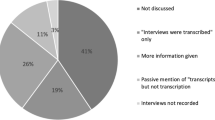Abstract
Interviewing offers the biographer unique opportunities for gathering data. I offer three examples. The emphatic bacterial geneticist Norton Zinder confronted me with an interpretation of Barbara McClintock’s science that was as surprising as it proved to be robust. The relaxed setting of the human geneticist Walter Nance’s rural summer home contributed to an unusually improvisational oral history that produced insights into his experimental and thinking style. And “embedding” myself with the biochemical geneticist Charles Scriver in his home, workplace, and city enabled me to experience the social networks that drive the practical events of his career, which in turn helped me explain the theoretical basis of his science. Face-to-face interaction and multisensory experience will shape each biographer’s experience uniquely. Recent developments in sensory physiology suggest that the experience of integrating sense data encourages different patterns of observation and reflection. It is reasonable, then, to think that biography based on face-to-face interviews will, for a given author, have a different character than one based entirely on documents. I reflect on how interviewing shapes my own writing and I encourage the reader to do the same.
Similar content being viewed by others
References
Barabasi, A.-L. 2002. Linked: The New Science of Networks. Cambridge, MA: Perseus Pub.
Cady, E.T., Harris, R.J., et al. 2008. “Using Music to Cue Autobiographical Memories of Different Lifetime Periods.” Psychology of Music 36: 157–177.
Clow, C.L., Scriver, C.R., et al. 1969. “Results of Mass Screening for Hyperaminoacidemias in the Newborn Infant.” Am J Dis Child 117(1): 48–53.
Clow, C.L., Reade, T.M. and Scriver, C.R. 1971. “Management of Hereditary Metabolic Disease. The Role of Allied Health Personnel.” New England Journal of Medicine 284(23): 1292–1298.
Comfort, N.C. 2001. The Tangled Field: Barbara McClintock’s Search for the Patterns of Genetic Control. Cambridge, MA: Harvard University Press.
Cowan, R.S. 2008. Heredity and Hope: The Case for Genetic Screening. Cambridge, MA: Harvard University Press.
Fowler, C. 2004. “Speech as a Supramodal or Amodal Phenomenon.” G. Calvert, C. Spence and B. Stein (eds.), The Handbook of Multisensory Processes. Cambridge, MA: MIT Press, pp. 189–202.
Keller, E.F. 1983. A Feeling for the Organism: The Life and Work of Barbara McClintock. New York: WH Freeman.
Lakoff, G. and Johnson, M. 1980. Metaphors We Live By. Chicago: University of Chicago Press.
Lindee, S. 2005. Moments of Truth in Genetic Medicine. Baltimore: Johns Hopkins University Press.
McClintock, B. 1950. “The Origin and Behavior of Mutable Loci in Maize.” Proceedings of the National Academy of Sciences of the United States of America 36: 344–355.
McClintock, B. 1951. “Chromosome Organization and Gene Expression.” Cold Spring Harbor Symposia on Quantitative Biology 16: 13–47.
McClintock, B. 1980. “Oral History.” W.B. Provine and P. Sisco (eds.), Krock Rare and Manuscript Collections. Cold Spring Harbor Laboratory, Long Island, NY: Cornell University Ithaca, NY.
Nance, W.E. 1959. “Twins: An Introduction to Gemellology.” Medicine (Baltimore) 38: 403–414.
Nance, W.E. 1967a. “Genetic Studies of Human Serum and Erythrocyte Polymorphisms: Glucose-6-Phosphate Dehydrogenase, Haptoglobin, Hemoglobin, Transferrin, Lactic Dehydrogenase, and Catalase.” Medical Genetics. Madison, WI: University of Wisconsin, p. 195.
Nance, W.E. 1967b. “Recent Developments in Genetics: Control Genes and the Genetic Code.” Journal of Bone and Joint Surgery (American Volume) 49(1): 183–191.
Nance, W.E. 1971a. “Genetic Counseling for the Hearing Impaired.” Audiology 10(4): 222–233.
Nance, W.E. 1971b. “The Principles and Practice of Genetic Counseling.” Annals of Otology, Rhinology and Laryngology 80(2): 246–254.
Nance, W.E. 2006. “Oral History.” N Comfort (ed.), Oral History of Human Genetics Project. Sewanee, TN: UCLA/Johns Hopkins University.
Nance, W.E. and Engel, E. 1967. “Human Cytogenetics: A Brief Review and Presentation of New Findings.” Journal of Bone and Joint Surgery (American Volume) 49(7): 1436–1454.
Nance, W.E., Elmore, S.M., et al. 1965. “Genetics and Orthopaedics.” Journal of Bone and Joint Surgery (American Volume) 47: 1260–1271.
Newell, F. 2004. “Cross-Modal Object Recognition.” G. Calvert, C. Spence and B. Stein (eds.), The Handbook of Multisensory Processes. Cambridge: MIT Press, pp. 123–139.
Paul, D.B. 1998. “The History of Newborn Screening for Phenylketonuria in the U. S.” Promoting Safe and Effective Genetic Testing in the United States: Final Report of the Task Force on Genetic Testing. Baltimore: Johns Hopkins University Press, pp. 137–160.
Perks, R. and Thomson, A. 2006. The Oral History Reader. New York: Routledge.
Portelli, A. 1990. Research as an Experiment in Equality. The Death of Luigi Trastulli, and Other Stories: Form and Meaning in Oral History. Albany, NY: State University of New York Press, pp. 29–44.
Root-Bernstein, R.S. 1989. Discovering. Cambridge, MA: Harvard University Press.
Scriver, C.R. 2006. “Oral History.” N. Comfort (ed.), Oral History of Human Genetics Project. Montreal, QC: UCLA/Johns Hopkins University.
Scriver, C.R. and Clow, C.L. 1980a. “Phenylketonuria: Epitome of Human Biochemical Genetics (First of Two Parts).” New England Journal of Medicine 303(23): 1336–1342.
Scriver, C.R. and Clow, C.L. 1980b. “Phenylketonuria: Epitome of Human Biochemical Genetics (Second of Two Parts).” New England Journal of Medicine 303(24): 1394–1400.
Scriver, C.R., Katz, L., et al. 1968. “Phenylketonuria and Diet.” Canadian Medical Association Journal 98(2): 124–125.
Scriver, C.R., Laberge, C., et al. 1978. “Genetics and Medicine: An Evolving Relationship.” Science 200(4344): 946–952.
Söderqvist, T. 2006. “What is the Use of Writing the Lives of Scientists?” R.E. Doel and T. Soderqvist (eds.), The Historiography of Contemporary Science, Technology and Medicine: Writing Recent History. London/New York: Routledge, pp. 99–127.
Spence, C. and McDonald, J. 2004. “The Cross-Modal Consequences of the Exogenous Spatial Orienting of Attention.” G. Calvert, C. Spence and B. Stein (eds.), The Handbook of Multisensory Processes. Cambridge, MA: MIT Press, pp. 3–25.
Watts, D.J. 1999. Small Worlds: The Dynamics of Networks Between Order and Randomness. Princeton, NJ: Princeton University Press.
Zinder, N. 1996. “Oral History.” N. Comfort (ed.), American Philosophical Society Library. Philadelphia, PA: Rockefeller University, New York, Ny..
Author information
Authors and Affiliations
Corresponding author
Rights and permissions
About this article
Cite this article
Comfort, N. When Your Sources Talk Back: Toward a Multimodal Approach to Scientific Biography. J Hist Biol 44, 651–669 (2011). https://doi.org/10.1007/s10739-011-9273-9
Published:
Issue Date:
DOI: https://doi.org/10.1007/s10739-011-9273-9




